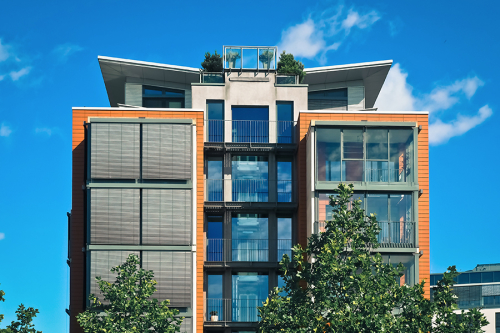Buying an apartment is usually among the largest purchases in a person's lifetime. In the second part of our blog series about Finnish real estate, we cover how to buy apartments in Finland.
Where to Find Apartments for Sale?
Typically, people search for apartments on the leading listing sites, which in Finland are:
You can also search for properties from various real estate agents’ websites, but leading listing sites give an overview of the whole market since all real estate agents also list apartments there. You can see all of Blok's apartments here.
Prices
How do you know what is a fair price for an apartment? The prices that are indicated on listings are claiming prices for those properties. This means that the seller has indicated that they are prepared to sell at this price. However, during so-called "bid-sales" or "tarjouskauppa", the initial listing price is artificially low in order to attract buyers. So don't be surprised if your bid gets rejected if you offer a listing in a "bid-sale".
House prices are always indicated as “Free-of-debt” prices (velaton hinta or vh.). It reflects the value of the apartment if all debts would be repaid and it wouldn't carry any of the housing company's outstanding debt. The “free-of-debt” price is selling price (myyntihinta) plus the apartments share of the housing company’s outstanding debt. Why are there prices indicated as “free-of-debt” prices? As the amount of debt varies from one apartment to another, “free-of-debt” prices place all apartments on a level playing field and makes it possible to compare them with each other.
A good way to estimate what the apartment could be worth is to look at what price similar apartments have been sold at. When looking for similar apartments consider the location (district), micro-location (if it’s close to a metro or train station, schools or the sea), size, floorplan, the age of the building.
The Ministry of Environment is providing a service that lists some of the housing deals that have been made in the past few years. You can search for prices of similar properties and what they have been sold for here: http://asuntojen.hintatiedot.fi/haku/. You can also try Blok’s free web-based valuator that gives a price range: http://valuator.blok.ai.
You can also see average square meter price for the most popular postcodes in Finland from our comparison service: https://blok.ai/en/neighbourhoods/.
Although average prices and past deals give a rough indication of the value of a similar type of apartment in the same area, it’s important to remember that each apartment is a unique object. Here are a few things that have been shown to affect the price negatively and positively:
Positive effects on price:
Seaview
Functional floorplan
A well-funded housing company
Recent surface renovations
Expensive renovations have been completed (pipe- or facade renovation)
Good local services and transport connections
A developing local area
Higher demand than supply (check how many other similar apartments are for sale in the same area, and for how long they have been up for sale to figure this out)
Negative effects on price:
High maintenance fee
Rented lot
The surface materials of the apartment are old
The various appliances that are a part of the apartment (e.g. fridge, oven) are old
Expensive renovations have not been completed (pipe- or facade renovation)
Permanent noise pollution from highways, trams etc.
Lower demand than supply (check how many other similar apartments are on sale in the same area, and for how long they have been up for sale in order to figure this out)
Financing
Most people in Finland finance their apartments with mortgages. Practically all retail banks offer mortgages. There are, however, differences in the margins that banks charge. Margins can be negotiated as they vary depending on your overall financial situation and how good of a customer you are for the bank. Big banks typically start by offering margins that are around 1-1.5%. It’s a good idea to shop around and negotiate for better margins. Depending on the situation, they can go as low as 0,6 – 0,7 %. Banks evaluate each customer separately and consider multiple factors: your income and ability to pay back the loan, your assets, creditworthiness and how good of a customer you are for that bank (do you have insurances or investments with the bank). The difference might seem minor, but for a 200 000€ loan with a 1% bank margin for 25 years, the bank will charge you 26 122€. If you manage to get a 0,3% lower rate you can save 8055€. That’s a pretty good saving by simply asking around different banks and making them compete for your business. Also, make sure to check if there are any fixed fees you must pay in addition to the margin. The lowest margin might not always be the most economical option.
Mortgage lending has become more regulated in the past years due to fears that households are accumulating too much debt, and to prevent overheating of the real estate market. To curb this development the government has introduced a cap on mortgages. This means that the total amount of a new mortgage can be at maximum 90% of the value of the guarantees attached to the loan (95% for first-time buyers). The primary mortgage guarantee is the apartment that is being bought. Because banks only account for 60-80% of the value of the apartment as a guarantee, the buyer must either have savings or other guarantees to cover the rest. Confusing? Yes, it’s slightly complicated and perhaps easier to understand through an example:
Example:
You want to buy an apartment worth 100 000€
The mortgage cap restricts possible mortgage to 90 000 euros (or 95 000€ if you’re a first-time buyer)
The bank accounts 70% of the value of the apartment as guarantee (70 000€)
You need to have 10 000€ in savings and, on top of that, 20 000€ in extra guarantees
If you want to purchase 100 000 € apartment without savings you need to have 31 111€ in extra guarantees (70 000€ + 31 111€ = 111 111€ * 90% = 100 000€)
Things to consider before buying
Upcoming Renovations
Check what renovations are scheduled for the next 5 years. Each housing company should have a renovation plan where this information can be found (“pitkän tähtäimen suunnitelma or PTS”). If such a document is not available, you can check what renovations have been completed in the past from the house manager's certificate (“isännöitsijäntodistus”). Financially the largest and most costly renovations are the pipe-renovations (roughly every 50-years), facade renovation (roughly every 30-40-years) and roof renovation (20-40-years). A typical pipe renovation can cost 750€/m2 or more, so knowing what additional costs are coming up is crucial. You should add up upcoming renovation costs to the purchase price so you know that you can afford them. Typically, it makes sense to purchase an apartment after major renovations have been completed, since statistically the market price for an apartment is lower compared to the pre-renovation cost + money spent on renovation. The advantage of buying before major renovations is that you can have a say in e.g. how your bathroom will look like. Additionally, price of the apartment is lower before major renovations, so it’s easier to secure a bank loan for apartment purchase.
Land Lease
If you’re buying an apartment from a house that is built on a rented lot, you should check if the rental period is running out anytime soon. Old rental agreements may be exceptionally cheap compared to the current market level, and when they eventually expire there might be a significant increase in the monthly land lease (included in the maintenance fee).
Housing Company Fees And Finances
Make sure to check what the maintenance fee of the housing company is so that you are aware of the monthly fee that you must pay each month to the company. Also, dive deeper into company finances in order to understand more about the financial situation. A higher than average maintenance fee might signal that the house is not in a good shape as it requires constant repairs, whereas, a lower than average maintenance fee might signal that the company has some additional revenue sources (rental income) that offset some of the costs.
Urban Development
How is the neighborhood developing overall? Are there major investments in nearby infrastructure? Investment in the surrounding urban area send a positive message about the neighborhood and has been shown to have a positive impact on residential housing prices.
Taxes And Fees
When purchasing an apartment in Finland you must pay a transaction tax (“varainsiirtovero”) that amounts to 2% of the apartments “free-of-debt” price. First-time buyers are exempt from this tax but are still required to report the purchase to tax authorities.
If you buy an apartment directly from the owner, you have 2 months to file and pay the transaction tax. If you buy an apartment through a real estate agent, the real estate agent will make sure you pay this tax immediately after signing the bill of sales. If buying directly from the owner, you bear the responsibility of doing this yourself.
You can find more information about the transaction tax at the tax offices website: https://www.vero.fi/en-US/Individuals/Buying_a_home
Registering as a Shareholder
Make sure to inform the housing company that you have purchased shares in the company so they can update the owner registry or "osakasluettelo". You can do this by submitting a copy of share document (asunto-osake), a bill of sales (kauppakirja), and a copy of tax receipts to the housing manager (isännöitsijä). If you buy an apartment through a real estate agent, the real estate agent will make sure you are added into owner registry.
Sellers Liability
If you find old or hidden flaws in the apartment that you weren't aware of at the time of purchase, the seller might be responsible for compensating you for these flaws. If you find such faults, you should inform the seller as soon as possible and specify the fault. The period during which the seller has liability over such factors ends after 2 years.
Make sure to also check our blog post about what you should know when owning or selling an apartment in Finland.






